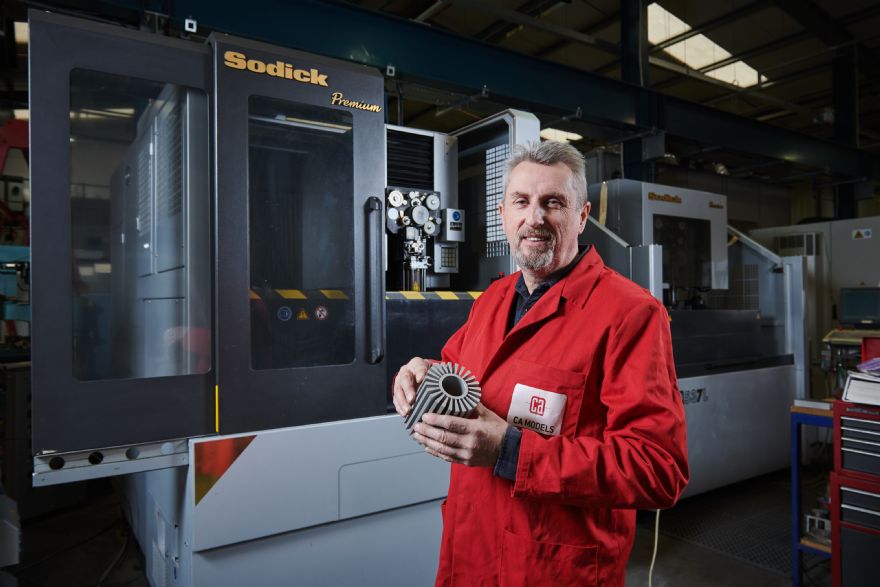
Stirling-based CA Models, a market-leading prototyping shop established nearly 40 years ago, says that Sodick wire erosion technology — supplied by the Warwick-based UK subsidiary Sodi-Tech EDM Ltd (
www.sodi-techedm.co.uk) — is now such an integral part of its business that “life without it would be unimaginable”.
The company has two Sodick wire EDM machines at its facility, including a Sodick AQ537L, which can accommodate workpieces up to 770 x 520 x 340mm.
CA Models was established by owner and managing director Clark Campbell in 1983, and he completed his first order — a model of a bright-yellow underwater camera — in the spare room of his flat. It was well received, and the young engineer decided that he wanted to compete with the best model makers in the UK.
He now employs 36 people, all focusing on the core business streams of additive manufacturing, precision CNC machining and specialist model making. ‘
Cutting-edge’ CNC machine-tool technologies are combined with model-making craftsmanship to provide high-quality products and a responsive service to customers in sectors such as aerospace, motor-sport, medical devices, and oil and gas. One of the technologies at the heart of the company’s operations is
wire EDM.
Mr Campbell says: “Our Sodick AQ537L provides outstanding accuracy and capability, making it popular for cutting punches and dies as part of the tool-making process. However, EDM goes far beyond just tool making at CA Models, having become indispensable to our business.”
In the early days, Mr Campbell built models by hand from physical drawings. The advent of CAD took the sector to another level, and CA Models started investing in CNC machines, the first being a four-axis mill.
Around 1996, the company invested in its first 3-D printer, which was based on the stereo-lithography (SLA) process. Today, it has 11 SLA machines, as well as an array of selective laser sintering 3-D printers for nylon prototyping applications — plus a number of fused deposition modelling (FDM) machines.
Metal prototypesAs the prototyping side of the business ‘took off’, so did the company’s machine shop, which prompted Mr Campbell to invest in his first Sodick wire EDM, around 15 years ago. In 2013, CA Models acquired its first 3-D printer for metal applications — a “momentous turning point” for the business.
“Today, we are inundated with enquiries from customers who want prototypes printed in metal. We have two metal 3-D printers, one making aluminium parts, the other producing 316 stainless-steel components. Moreover, we have just spent 1.8 million euros on a 3-D printer that can produce parts in titanium, along with a large five-axis universal
machining centre.”
Mr Campbell says these machines blend in well with the company’s Sodick wire EDMs. “We use the Sodick AQ537L for a multitude of purposes. For instance, although we receive a lot of orders for prototypes that only require wire erosion, we have found that the EDM is extremely useful for supporting our metal 3-D printing technology.
Anyone who is familiar with metal 3-D printing will know that it is only accurate to a certain degree, but if we are working on an aerospace or defence project, for example, the customer will often want 4µm accuracy.
In this instance, we will take the metal 3-D printed part and — depending on its geometry — either wire-erode it or five-axis machine it to the required tolerance. There are only a few companies using wire erosion to support metal 3-D printing in this way.”

A lot of the prototypes produced at CA Models fit within a 250mm cube work envelope, and a number of them are processed by the Sodick AQ537L, which was installed purely to boost the company’s wire-erosion capacity and support of an older but larger Sodick model.
On a day-to-day basis, the AQ537L produces various high-precision prototypes for sectors such as medical-device, military/defence and product design. Most of these are one- or two-offs and made from materials ranging from alloys through to hard steels.
Component removalWhen the company has completed a full-metal 3-D print build, the best way to remove components from the support plate is to use wire erosion. Mr Campbell said: “The AQ357L makes a beautiful job of this.
Indeed, once the process is finished, the support plate looks brand-new and ready to use again. Wire erosion has become very important to our business, and I cannot see us ever being without it. If there were no wire erosion machines here, we would have to out-source and be at someone else’s ‘beck and call’.
“I can remember when I received my first order from a Formula One team. It was for an SLA model about 200mm long, and I was given one week by my contact to manufacture and deliver the model. Today, the same contact, who now works at a different Formula One team, gives me 48hr to provide 24 SLA models.
“This is the world we operate in regarding lead times, and why we need an in-house resource when it comes to wire erosion. Every time we have a really accurate part or feature to produce, and the clock is ticking, the AQ537L comes to the rescue.
“Furthermore, we sell on quality, so when we have to hit a tight tolerance, it’s reassuring to know that we have the capability in place.”